Neil Diamond’s influence on the music industry is both profound and enduring. His timeless songs continue to resonate with audiences worldwide, striking emotional chords and inspiring generations of listeners. His recognition at the Kennedy Center Honors stands as a tribute to his extraordinary career and the lasting legacy he’s carved in the cultural fabric of American music.
Far more than a routine celebration, the Kennedy Center Honors represent one of the highest accolades in the arts—reserved for those whose creative work has deeply enriched American culture. Neil Diamond’s inclusion in this elite circle reflects the magnitude of his contributions and the respect he commands in the music world. His presence at the ceremony was a powerful reminder of the breadth of his impact.
Among the evening’s most memorable moments was Lionel Richie’s heartfelt tribute to Diamond. A music icon himself, Richie chose to honor Diamond with a soul-stirring rendition of “I Am… I Said”—a song that holds deep personal meaning for its creator. Richie’s performance wasn’t just a tribute—it was a poignant expression of admiration from one legend to another.
Dressed sharply in a black suit, Richie poured emotion into every note, transforming the song into a deeply personal homage. A particularly moving touch was his lyrical nod to his hometown, inserting “Tuskegee” in place of a city in the original lyrics—a gesture that added a layer of sincerity and intimacy to the performance. The impact was immediate and powerful, visibly touching Diamond.
The raw emotional energy of that moment reverberated far beyond the auditorium, igniting a flurry of praise across social media. Fans were deeply moved by Richie’s performance and its significance.
One viewer on YouTube remarked, “Lionel Richie is a gift—not just to music, but to humanity. His tribute to Neil was heartfelt and beautifully delivered. Watching Meryl Streep observe Neil’s reaction was unforgettable.”
Another fan added, “Both of these men are treasures in their own right. Whoever selected Lionel Richie for this tribute made an inspired choice. His voice was perfect for the song, but Neil’s emotional response said even more than the audience’s applause.”










